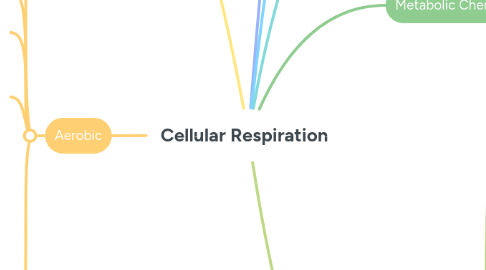
1. Aerobic
1.1. Krebs Cycle
1.1.1. Location
1.1.1.1. Prokaryotic cells: Cytoplasm
1.1.1.2. Eukaryotic cells: Mitochondrial Matrix
1.1.2. Purpose is to produce electron carriers and make some ATP
1.1.3. Acetyl coA ➡️ 4 CO2 + 2 ATP + 6 NADH + 2 FADH2
1.1.4. GTP, the energy molecule equivalent to ATP is made through substrate-level phosphorylation
1.2. Oxygen is required
1.3. High yield (~36 - 38 ATP)
1.4. Products
1.4.1. CO2
1.4.2. Water
1.5. Electron Transport Chain
1.5.1. Location
1.5.1.1. Prokaryotic cells: Cell membrane
1.5.1.2. Eukaryotic cells: Mitochondrial Inner Membrane
1.5.2. Electrons become oxidized and reduced when going through the proteins in the chain
1.5.2.1. ATP Synthesize (channel protein)
1.5.2.1.1. As hydrogen ions are desperate to get away from each other, they rush into the channel protein
1.5.2.1.2. It uses the kinetic energy
1.5.2.1.3. convert ADP→ ATP
1.5.2.1.4. Chemiosmosis: Efficient in producing ATP
1.5.3. From high H+ concentration to low H+ concentration
1.5.4. 6 NADH + 2 FADH2 + O2 ➡️ 34-36 ATP, Water, 6 NAD+ and 2 FAD+
2. Inhibitors
2.1. Cyanide
2.1.1. Toxic when consumed in high amounts
2.1.1.1. It will inhibit aerobic cellular respiration
2.2. Arsenic
2.2.1. Inhibits the oxidative phosphorylation reactions of the Krebs cycle.
3. What is it?
3.1. The controlled release of energy from organic compounds to produce ATP (energy).
3.1.1. It's a function of life that ALL living organisms perform
4. ATP = energy currency for the cell
4.1. ATP is composed of a sugar (ribose) and a base (adenine) connected to 3 phosphate groups
4.1.1. Because of that, ATP is able to donate a phosphate.
4.1.1.1. Thus, phosphorylation activates all kind of input reactions.
4.2. Cells need energy for:
4.2.1. Synthesie large molecules like DNA, RNA, and proteins
4.2.2. Pump molecules or ions across membranes via active transport
4.2.3. Moving things around inside the cell, such as chromosomes, vesicles...
5. Chemical Formula
5.1. C₆H₁₂O₆ + 6O₂ ➡️ 6CO₂ + 6H₂O + ATP + Heat
5.2. Reactants ➡️ Products
6. Metabolic Chemical Reactions
6.1. Oxidation
6.1.1. Oxygen is added, hydrogen is removed, loss of electrons
6.2. Reduction
6.2.1. Oxygen is removed, hydrogen is added, gain of electrons
6.3. Phosphorylation
6.3.1. Phosphate is added to a molecule
6.4. Decarboxylation
6.4.1. Carbon is removed
7. Anaerobic
7.1. Location
7.1.1. Eukaryotic and Prokaryotic cells = Cytoplasm
7.2. Oxygen is not required
7.2.1. ATP is needed
7.3. Gives a small, but quick yield of ATP from glucose (~2 ATP)
7.4. Useful when:
7.4.1. Quick burst of energy
7.4.2. In environments that are deficient of oxygen
7.5. Products
7.5.1. Lactic Acid (animals & humans)
7.5.2. Ethanol and CO2
7.6. Glycolysis
7.6.1. Glucose is broken down into two pyruvate (3 carbon) molecules.
7.6.2. Glucose + ATP + NAD+ ➡️ 2 Pyruvates + 2 ATP + 2 NADH
7.7. Fermentation
7.7.1. Making more ATP in an anaerobic environment without using the mitochondria, but the cytoplam
7.7.1.1. This occurs sometimes after glycolysis, when the environment is not yet aerobic
7.7.1.1.1. Lactate is produced in muscles during fast exercises when the body cannot supply enough energy for aerobic respiration in the mitochondria
7.7.2. Pyruvate molecules from glycolysis are converted into lactate or ethanol
7.7.2.1. This process makes 2 ATP molecules through substrate level phosphorylation and regenerates NAD+
7.7.3. 2 Pyruvate + 2 NADH ➡️ Lactate or Ethanol + CO2 + 2 ATP + NAD+
